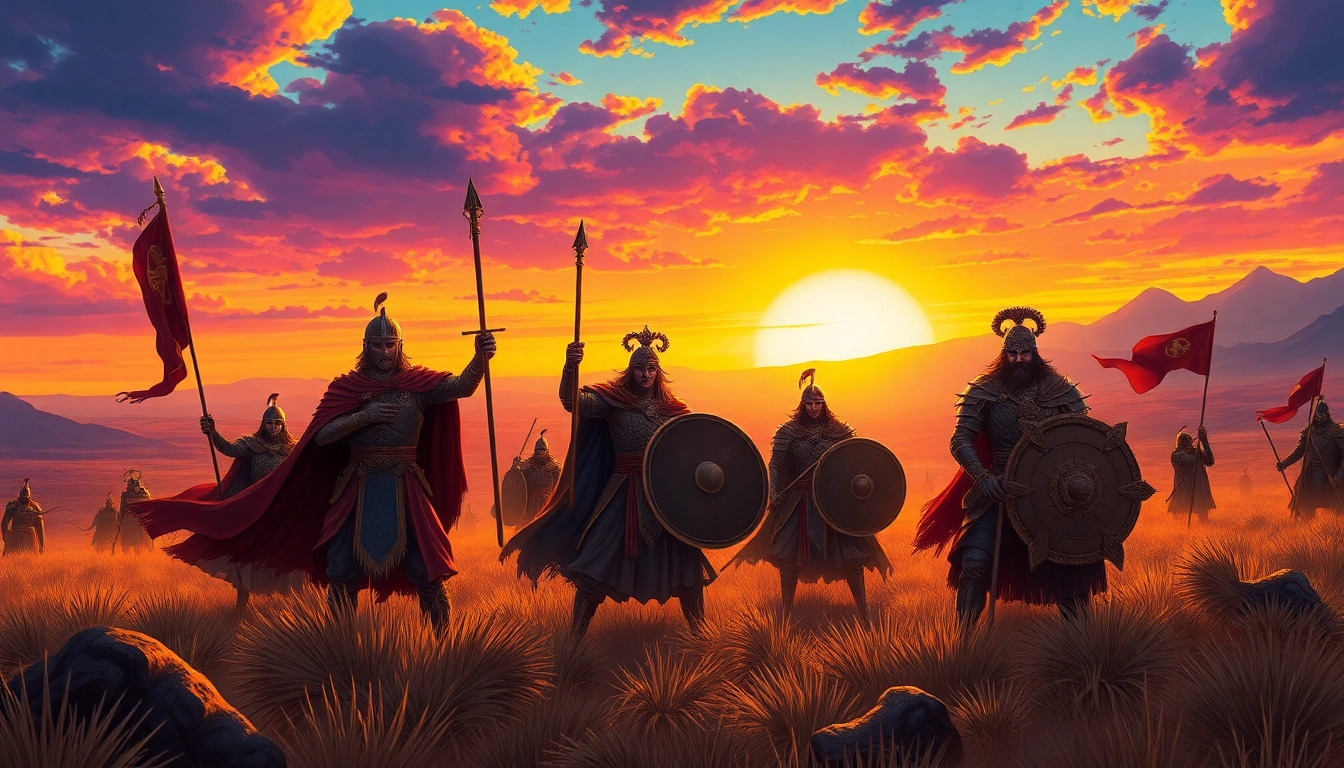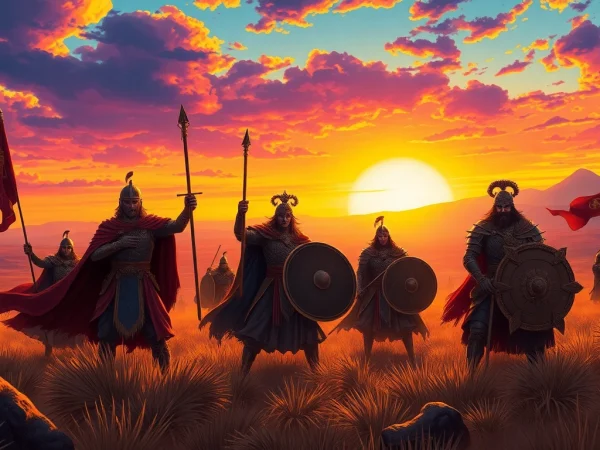Mastering Strategy: Insights into Historical Warlords and Their Impact on Warfare
Understanding the Role of Warlords in History
The Definition and Evolution of Warlords
The term warlords historically refers to military leaders who wield significant power, often outside the bounds of formal governmental structures. Unlike traditional sovereign rulers, warlords emerge in chaotic environments, seizing control through military prowess, political maneuvering, or economic influence. Their evolution can be traced back to ancient times when tribal leaders commanded loyalty based on kinship or allegiance, often resulting in localized power dynamics that served as precursors to more centralized states.
Over time, the concept of the warlord has shifted—particularly during periods of significant upheaval or conflict. The fragmentation of state power, as seen during the collapse of empires, led to the rise of warlords who filled the vacuum left behind. This transformation reflects not only the sociopolitical landscape but also the varying roles warlords play, whether as protectors or oppressors. Their legacies are often intertwined with the narrative of the regions they dominate, highlighting the dual nature of their existence in both historical value and moral complexity.
Key Historical Warlords and Their Legacies
History is replete with warlords who left indelible marks on their societies. Genghis Khan, perhaps the most famous warlord in history, demonstrated incredible strategic acumen during his campaigns, uniting the Mongol tribes and creating the largest contiguous empire the world has ever seen. His legacy is a mixture of brutal conquest and the establishment of trade routes that spurred cultural exchanges.
Similarly, the infamous Vlad the Impaler, while notorious for his methods, also played a crucial role in defending Wallachia against the Ottoman Empire. His fierce reputation has been romanticized in literature, intertwining historical fact with myth, thereby enhancing his enduring presence in popular culture.
The aftermath of World War II also saw the emergence of numerous warlords within former colonial territories, where political structures were weak or non-existent, exemplifying the broader patterns of power vacuums and opportunism. The legacies of these figures provide crucial insights into the socio-political fabric of their times, revealing the complex interplay between power, violence, and legitimacy.
The Warlord’s Influence on Military Strategy
Warlords have historically influenced military strategy by integrating tactics that reflect both their immediate requirements and broader socio-political contexts. Their strategies often favor mobility, surprise, and the use of terrain to their advantage, setting a precedent for modern guerrilla tactics. Besides conventional combat, warlords adeptly utilize psychological warfare, mobility, and deception to gain the upper hand against opponents, often leading to unexpected victories.
This adaptability is illustrated in the exploits of figures like Hannibal Barca, who used innovative strategies during the Second Punic War against Rome. His remarkable use of elephants to traverse the Alps is a testament to the audacity and effectiveness of unconventional tactics. In a more contemporary context, the strategies of modern warlords in regions like Afghanistan underscore the continuing relevance of these principles in asymmetric warfare.
Characteristics that Define Successful Warlords
Leadership Qualities and Decision-Making Skills
Successful warlords are distinguished by a unique set of leadership qualities. Their ability to inspire loyalty among troops is paramount; this often involves not just military capability but the forging of personal bonds with soldiers. Charisma, decisiveness, and the ability to instill confidence in their ranks are traits commonly found in effective warlords. Furthermore, their decision-making is often characterized by a blend of tactical genius and situational awareness, allowing them to pivot quickly when circumstances change.
For instance, the Islamic warlord Saladin is revered not only for his military successes but for his diplomatic acumen and ability to unite disparate factions against a common foe, exemplifying how leadership qualities extend beyond mere combat prowess to encompass broader strategic vision.
Resource Management and Troop Morale
A warlord’s success is also deeply tied to their capability in resource management and troop morale. Effective allocation of resources, including food, weaponry, and financial support, can dictate the sustainability of an army. Warlords often relied on local economies and their command of supply routes to ensure their forces are adequately equipped and motivated. This economic savvy extends to the understanding of local customs, labor forces, and alliances that can be leveraged to maintain and grow their power.
Maintaining troop morale is essential; successful warlords often employ psychological strategies to keep their soldiers committed. The ability to craft narratives around their missions, whether romanticizing their cause or ingratiating themselves with the locals, plays a crucial role in sustaining loyalty among troops, influencing their willingness to fight fervently for a leader’s vision.
Adaptation to Changing Warfare Dynamics
Warlords frequently display remarkable adaptability in response to the evolving dynamics of warfare. As technology changes, so too do the tactics employed by warlords. For example, the introduction of gunpowder drastically transformed battlefields, and those who could integrate these new technologies into their strategies often gained decisive advantages. Historical figures such as Zhuge Liang understood the need to incorporate innovations, blending traditional tactics with new weaponry to secure victories against his foes.
Moreover, the capacity to adapt to shifts in political landscapes, such as forming temporary alliances in the face of a more considerable threat, illustrates the strategic foresight inherent in successful leaders. This adaptability is essential not only in military contexts but also in navigating the intricate socio-political webs that define their domains.
Warlords and Their Strategies in Combat
Traditional vs. Modern Warfare Tactics
The tactics employed by warlords have evolved significantly over the centuries, leading to a fascinating juxtaposition between traditional and modern warfare. Conventional warfare typically involves large forces engaging in set-piece battles, while modern warfare—particularly in the context of warlords—is characterized by guerrilla tactics and hit-and-run engagements that leverage speed and surprise to offset numerical disadvantages.
Historically, warlords depended on large armies to confront rival forces head-on; however, modern interpretations have adapted these strategies to consider elements like intelligence gathering, mob tactics, and the strategic use of technology, such as drones and cyber warfare. The adaptability of tactics is evidenced in the actions of modern insurgent leaders, who have utilized social media to rally troops and share intelligence.
The Use of Deception and Psychological Warfare
Deception plays a pivotal role in the conduct of warlords, shaping how battles are fought and how confidence is built among fighters. The strategic application of misinformation can sow doubt among opponents, leading them to make tactical miscalculations. Historical examples include the use of feigned retreats, as employed by legendary generals like Alexander the Great, to lure enemies into traps.
In more modern contexts, psychological elements of warfare have increasingly incorporated media rhetoric and propaganda, giving warlords a broader and more powerful arsenal to manipulate perceptions both on and off the battlefield. The successful use of these tactics can significantly alter the morale of opponents, just as it can bolster confidence among troops.
Case Studies of Notable Battles Led by Warlords
Analyzing key battles provides insight into the tactical evolution of warlords. The Battle of Zama (202 BC), where Scipio Africanus defeated Hannibal, exemplifies the critical balance of traditional elements against the backdrop of innovative strategies. Scipio leveraged knowledge of Hannibal’s tactics, employing cavalry to outmaneuver and surprise the Carthaginian forces, proving the importance of adaptability and preparation.
In contrast, the Battle of Agincourt (1415) represents a defining moment for English forces, under Henry V, where the use of longbowmen against a larger French cavalry force showcased a transformational shift in military tactics. These case studies highlight how effective planning, adaptation, and a clear understanding of both one’s forces and the enemy can lead to triumphant outcomes, influencing the very fabric of military history.
Lessons from Historical Warlords for Today’s Leaders
Strategic Thinking in Business and Governance
The strategies of historical warlords offer invaluable lessons for contemporary leaders in business and governance. Strategic thinking, as exemplified by figures like Julius Caesar, who understood the importance of both offense and defense, remains a cornerstone of effective leadership. Caesar’s ability to craft flexible strategies based on constantly changing circumstances serves as a reminder that successful leaders must remain vigilant and adaptable in their approaches.
Moreover, warlords’ experiences can guide modern leaders in times of uncertainty. The capacity to read the environment, anticipate challenges and craft innovative solutions is as relevant in the boardroom as it is on the battlefield. With the rapid pace of technological change and market dynamics, the strategies employed by historical figures provide a template for navigating contemporary challenges.
Negotiation and Alliance-Building Insights
The art of negotiation and alliance-building is another key area where today’s leaders can draw insight from warlords. Successful warlords were often adept at forging temporary alliances to achieve specific objectives, a principle that can be instrumental in modern business environments where collaboration often leads to greater successes. The alliances formed by leaders like Genghis Khan allowed for expanded influence and shared resources, which in turn facilitated military and economic success.
These insights apply to both corporate partnerships and geopolitical relations, underscoring the importance of building coalitions to enhance bargaining power and create avenues for strategic advantage. Understanding how to leverage relationships for mutual benefit is a time-tested lesson that transcends boundaries.
Resilience and Adaptability in Leadership
Finally, the resilience and adaptability demonstrated by historical warlords serve as vital attributes for any leader facing adversity. Resilience—the capacity to recover quickly from difficulties—was exemplified by leaders like Frederick the Great, who, despite initial setbacks, displayed remarkable tenacity and strategic foresight, ultimately securing Prussian dominance.
Adaptability, equally important, allows leaders to pivot in response to shifting landscapes, embracing new challenges without losing sight of their core goals. This duality of traits enables leaders to navigate the complexities of their environments, remain steadfast in their missions, and inspire those around them to follow suit.
The Future of Warlord Narratives in Gaming and Media
How Warlords are Portrayed in Modern Video Games
As virtual spaces evolve, the portrayal of warlords in video games has transformed contemporaneously with societal attitudes towards power and conflict. Games like “Warlords II Deluxe” encapsulate the archetype of the warlord, presenting players with choices that emphasize strategy, resource management, and the consequences of decision-making. Here, players often find themselves managing not only military operations but also the socio-political complexities typical of historical warlords.
This portrayal not only entertains but educates players about the intricacies of power dynamics and leadership challenges, merging historical insights with practical decision-making frameworks. The immersive nature of these games allows for a deeper understanding of the traits that define successful warlords, transcending the traditional boundaries of learning.
Influence of Warlord Archetypes in Film and Literature
In popular media, warlords are often depicted as complex characters embodying both heroism and villainy. Films and literature frequently explore the moral ambiguities surrounding their quests for power, leading audiences to question notions of right and wrong. Characters like Tyrion Lannister from “Game of Thrones” reflect the cunning and strategic prowess typical of historical warlords, offering nuanced portrayals that capture both their motivations and consequences.
This cultural representation serves not only as entertainment but also as a commentary on leadership, authority, and the human condition, prompting viewers to reflect upon historical precedents and contemporary challenges in governance and society.
Engaging Audiences through Historical Narrative
The storytelling approach to historical narratives featuring warlords presents an effective tool for engaging audiences. By weaving personal stories with grand historical events, filmmakers, game developers, and authors can create compelling narratives that resonate on both intellectual and emotional levels. The interplay between myth and history in these narratives informs modern perceptions of power while fostering a sense of connection to the past.
Moreover, the lessons gleaned from these narratives encourage discussions about resilience, adaptability, and the moral dimensions of leadership, shaping the discourse around what it means to be a leader in any context. Engaging audiences in this manner can bridge the gap between history and present-day challenges, illuminating the paths taken by those who have shaped our world.










